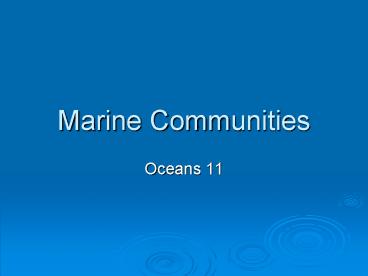Marine Communities - PowerPoint PPT Presentation
1 / 16
Title:
Marine Communities
Description:
Marine Communities Oceans 11 Ocean Zones The ocean can be divided into many zones. The ocean bottom is the Benthic zone The water itself (or the water column) is the ... – PowerPoint PPT presentation
Number of Views:241
Avg rating:3.0/5.0
Title: Marine Communities
1
Marine Communities
- Oceans 11
2
Ocean Zones
- The ocean can be divided into many zones.
- The ocean bottom is the Benthic zone
- The water itself (or the water column) is the
Pelagic zone. - The Neritic Zone is that part of the pelagic zone
that extends from the high tide line to an ocean
bottom less than 183 m deep. - Water deeper than 183 m is called the Oceanic
zone.
3
(No Transcript)
4
Light Zones
- Photic Zone This is the top layer, nearest the
surface. Here there is enough light penetrating
the water to support photosynthesis. - Aphotic Zone Ninety percent of the ocean is in
the aphotic zone. It is entirely darkthere is no
light.
5
Marine Communities
- We will take a closer look at the following
marine communities - Rocky Shore
- Salt Marsh
- Coral Reef
- Vent Communities
6
1. Rocky Shores
- Marine plants and animals that live along these
rocky shores have adapted to a habitat that
changes every day (high tide / low tide). - These organisms must also be able to withstand
the waves which often hit with incredible force.
7
Rocky shore continued
- Example organisms Barnacles, crabs, periwinkles,
seaweeds, clams, sea urchins.
8
2. Salt Marshes
- Salt marshes are wetlands.
- Sometimes the marsh has little water, sometimes
it is dry, and sometimes it is very full of
wateralmost like a pond. - Their salinity, or salt content, varies. Salt
marshes are extremely productive.
9
Salt Marshes Continued
- Microscopic organisms like bacteria, fungi, and
algae make their home in the decaying marsh
grasses. - These decaying plants and micro-organisms are
then eaten by fish, worms, and crustaceans,
furthering the cycle of decomposition. - The plentiful insects provide food for birds and
fish.
10
3. Coral Reef Communities
- A reef is a coral community consisting of several
thousand organisms living together. Although it
looks like a dormant underwater bush, the reef is
very much alive.
11
Reefs continued
- Because of warm water and abundant food supply,
coral reef communities are bursting with life. - Reefs with their bush like shape offer many nooks
and crannies for fish to hide in.
12
4. Vent Communities
- Characteristics
- It is entirely darkthere is no light.
- The water pressure is extreme.
- The temperature is near freezing.
- How does life exist???
13
Vent Communities continued
- The living things found here live close to cracks
in the Earth's crust. - These cracks give off mineral-rich materials from
the Earth itself. - Chemosynthetic bacteria utilize hydrogen sulfide
from the cracks for energy to make food.
14
Vent communities continued
- Example organisms
- Chemosynthetic bacteria, angler fish, tripod
fish, sea cucumber, snipe eel, vent shrimp, tube
worms, and vampire squid.
15
Angler fish
16
The End!































